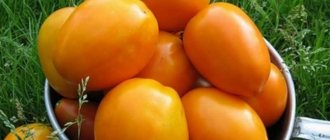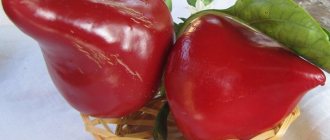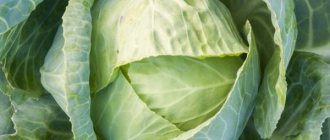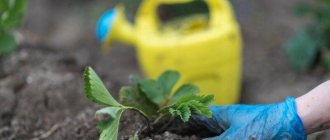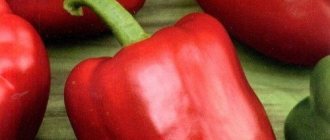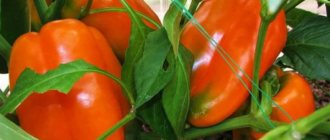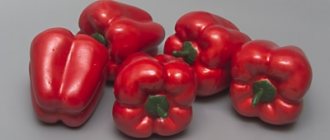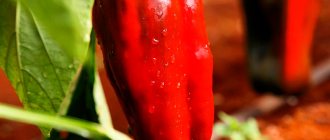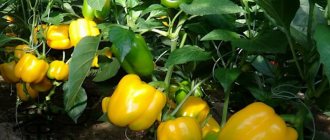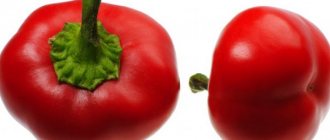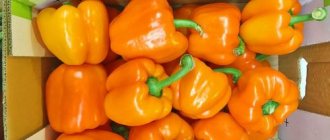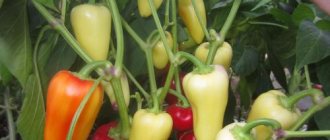Pepper Bogatyr is chosen for planting on a personal plot for its merits. It is unpretentious in care and produces a good harvest throughout the season. The fruits are large, attractive in appearance, sweet in taste and healthy for the body.
Pepper Bogatyr
Pepper seeds Bogatyr
Pepper Bogatyr has large and juicy fruits
History of the variety's creation
Bell pepper Bogatyr was bred by breeders from the Moldavian Research Institute in the last quarter of the last century. The knotted bitter pepper was taken as the basis for developing a new vegetable crop. Bell pepper was included in the State Register of Russia in 1996.
Subsequently, specialists from the Poisk agricultural company carried out work to adapt this vegetable crop for planting in the North Caucasus and Lower Volga. In addition, Bogatyr pepper grows well and bears fruit in all regions of Moldova and Ukraine.
The sweet pepper variety Bogatyr can grow in gardens in open ground and in greenhouses in the Moscow region and the middle zone.
Sweet pepper Bogatyr. Brief overview, description of characteristics - video
Picking seedlings
The procedure is carried out after the appearance of 2 leaves on the seedlings, since sweet peppers do not tolerate transplantation well. The following points must be taken into account:
- Water the container with seedlings generously with water. At this time, prepare small pots, wash them with potassium permanganate and fill them with soil, the composition of which is identical to that for sowing seeds.
- Carefully take the sprout by the leaves, pry it from below with a spoon and carefully transfer it along with the soil into a new container and add soil on top. Be sure to water.
- The pots can be placed on the windowsill, but cover the glass with paper to avoid direct rays.
- The temperature of the medium for peppers after picking should not be lower than 15°C, otherwise their growth may stop.
- Seedlings need to be fed. To do this, you can use ready-made formulations (“Krepysh”, “Fertika Lux”). The first feeding is carried out 2 weeks after picking, and the second - after another 2 weeks.
- 3 days before planting in open ground, keep the seedlings outside overnight for hardening.
Pepper Bogatyr: description of the variety
Pepper Bogatyr is a mid-season variety, the first light green fruits of which are harvested 4 months after germination of the seed material. And fully ripe, bright red peppers are harvested after about a couple of weeks.
On a note!
The main positive quality of the Bogatyr variety is the possibility of active fruit ripening when growing the crop in partial shade or lack of lighting.
The seed material of this bell pepper is sold by several Russian agricultural companies.
Photo of pepper Bogatyr
The following qualities are common to all these varieties of Bogatyr pepper:
- The bushes are strong and strong, the leafy shoots are of medium thickness, the bushes themselves have a spreading shape, with a large number of side shoots.
- The foliage is typical for bell peppers, medium in size, rounded-elongated with sharp tips, glossy with a characteristic shine, dark emerald in color.
- Ripe peppers of the Bogatyr variety are large in size, the surface is lumpy, with a shiny, rather thin skin, appearing on almost every shoot.
- The fruits have from 2 to 4 seed chambers with a sufficient number of seeds, the wall thickness is average, about 0.7 mm.
- The pulp of ripe Bogatyr pepper fruits has a sweet taste, is quite juicy and has a pleasant aroma.
- The fruits can be eaten already at the stage of technical maturity, when they have a light green color; peppers are fully ripe when they turn bright red.
Harvesting
With regular loosening, watering and pruning, Bogatyr from a small seed grows into a half-meter bush with eight to ten thick-skinned fruits. The technical maturity of pepper occurs on the 135th day from the date of emergence. The fruits are green. Biological maturity occurs after another two weeks. Peppers acquire a bright red, rich, uniform color.
Peppers can be picked from the bush while they are still green; they are put in a dark place to ripen or processed. The freed bushes are gaining strength for the second wave of the harvest. Fruiting can continue until the first frost.
Main characteristics of Bogatyr pepper from different manufacturers
In Russia, several agricultural firms are engaged in the sale of seeds of this bell pepper, each of which Bogatyr differs slightly in its main characteristics:
- “SeDek” - the height of their bushes is about 0.5-0.7 m, the shape of the fruit is in the form of a cone up to 11 cm long and weighing 90-120 cm;
- “Siberian varietal seeds” - shoot height reaches 0.3-0.4 m with a cuboid shape of ripe peppers, up to 10 cm long and weighing 90-120 g;
- “Aelita” - with a shoot height of about 65 cm, a cone-shaped ripe fruit, up to 17-18 cm long and weighing up to 160-190 g.
Photo of Bogatyr pepper seeds from
Fresh peppers contain a large amount of ascorbic acid, other vitamins and minerals, but during heat treatment the peppers lose about half of these substances.
The harvested crop is of universal use; the fruits can be used fresh, added to salads and snacks, canned, cooked for hot dishes, and also frozen for the winter in the freezer.
On a note!
Ripe fruits of Bogatyr pepper tolerate transportation well and can be stored for quite a long time in appropriate conditions.
Preparing seeds for sowing
- Usually, seeds no older than 3 years are used for sowing, since fresh material has the best germination.
- Then the seeds are kept in a solution of table salt (5%) for half an hour. In this case, low-quality seeds will float - they are unsuitable for planting.
- Next, the selected seeds are placed in a weak solution of potassium permanganate for disinfection (1 g of potassium permanganate per 100 ml of water) for half an hour.
- And the final step will be to immerse the seeds for 3 hours in a growth stimulator to increase productivity.
- Now they begin to germinate the planting material. To do this, the seeds are wrapped in a damp cloth and left for a week at a temperature of 25°C. The fabric needs to be moistened from time to time.
Advantages and disadvantages of Bogatyr pepper
The main advantages of the Bogatyr bell pepper variety include:
- germination rate of seed material is close to 100%;
- good yield;
- the variety develops well and ripens in the shade;
- quickly adapts to temperature changes;
- this vegetable crop can be grown in garden beds in open ground, in greenhouses and film greenhouses;
- good presentation and excellent taste of ripe fruits;
- fruiting is extended over time;
- ripe peppers tolerate transportation well and have good shelf life;
- Bogatyr pepper is resistant to many diseases that affect other varieties of bell pepper;
- ripe pepper is very useful for humans in any form;
- the collected fruits are distinguished by their versatility.
Among the disadvantages of the Bogatyr variety, the following should be noted:
- bushes of this variety are often attacked by aphids;
- During periods of drought, the bushes may wither, so it is important to regularly water the beds with this variety of pepper.
Diseases and pests
Most peppers are susceptible to various viral, fungal, and bacterial diseases of nightshades. Plants suffer especially badly in bad weather.
The most common diseases are:
- Phytoplasmosis is a disease that begins with damage to the tops - the leaves curl and dry out. The fruits develop incorrectly, become smaller, and the plant takes on a dwarf shape.
- Blackleg is a fungal disease that affects the lower part of the plant stem.
- Fusarium is a disease caused by a fungus that attacks the blood vessels of plants. If there is a malnutrition, the leaves gradually turn yellow and dry out.
- Verticillium - the disease begins with a gradual discoloration of the leaves, the surface of which becomes corrugated over time. At the beginning of flowering, the plants wilt sharply.
- Late blight is a disease caused by a fungus that begins with the appearance of dark spots on the leaves and stems, later spots appear on the fruits.
- Cladosporiosis is a disease of greenhouse plants, caused by a fungus, manifested in the appearance of brown spots on the leaves.
According to the description of the variety, “Bogatyr” pepper is relatively resistant to diseases such as verticillium, tobacco mosaic and late blight.
However, most pepper diseases affect plants if pathogenic bacteria and fungi are in the soil, on seeds or garden equipment.
To avoid infection you must:
- Follow the rules of crop rotation - plant plants in their original place, or after other nightshade crops, no earlier than three years later.
- Disinfect the greenhouse, all equipment, as well as greenhouse soil with a solution of potassium permarganate, phytosporin or other antibacterial drugs.
- Preparing seeds and growing seedlings correctly.
- Control pests that carry diseases.
- Follow the rules of agricultural technology for growing plants in greenhouses.
If signs of disease appear on individual plants, they must be removed and burned, and the remaining peppers must be treated with the necessary preparations - fungicide, copper sulfate, phytosporin.
The pests that are most dangerous for peppers - spider mites, aphids, Colorado beetles - can be combated using various folk remedies - infusions of tobacco, garlic, wormwood, birch tar. Large farms use insecticidal spraying.
When digging the soil, you can notice small yellow worms - wireworms and larger, white larvae of the cockchafer. If not destroyed, they can also damage plants by gnawing on roots.
Prevention from wireworm infestation is by liming the soil. You can also treat the soil with a preparation - bazudine - before planting.
The Bogatyr variety is resistant to diseases thanks to the efforts of breeders. Pests do not show much interest in its harsh foliage and stems. If pests appear, spray the plants with insecticides, but these cases are extremely rare.
How to properly plant Bogatyr peppers and care for seedlings
The Bogatyr pepper variety is usually grown in seedlings, and the harvest is fully harvested in almost any Russian region and subject to a short, cool summer.
Seed material for seedlings should be planted in the last ten days of February - the first ten days of March. Usually, strong and healthy seedlings are planted in a permanent place at the age of 65-75 days, while the plants already have well-developed roots, as well as the above-ground part - 5-6 permanent leaves appear on the shoot by the time of planting.
BOGATYR PEPPER - ONE OF THE LARGEST - video
Preparation of seed material
Seeds purchased in specialized stores do not need pre-sowing treatment, as they were prepared for planting by specialists from the agricultural manufacturer.
Pepper seedlings and diseases:
Diseases of sweet bell peppers
But the seed material collected from your own garden should be prepared before planting:
- Bogatyr pepper seeds are dipped in salted water for half an hour, and only those that have sunk to the bottom of the plate are selected for planting. They are taken out and washed under running water, and those that float on the surface should be thrown away;
- the selected seed material for disinfection is immersed in a weak solution of potassium permanganate for 30 minutes;
- then the seeds are placed in a growth stimulator solution for a couple of hours.
After all the procedures carried out, the Bogatyr seed material must be wrapped in a damp cloth for germination. The material from the spray bottle should be wetted periodically. Usually the seeds hatch in 5-7 days.
Advice!
Sprouted seed material should be placed in the refrigerator for several hours to harden before planting in containers.
Yellow pepper hybrid!
Pepper Gemini
Sowing and caring for seedlings
It is better to immediately plant the sprouted seeds of sweet pepper Bogatyr in separate plastic or peat pots, so as not to injure the delicate root system of bell pepper seedlings by picking.
Before using containers or cups, they are treated with a weak solution of potassium permanganate.
You can buy a nutrient substrate in specialized stores or make it yourself at home. To do this, mix humus, compost and river sand in the following proportions: 2:1:1. To disinfect such a substrate, it should be spilled with a weak solution of potassium permanganate.
Important!
Containers or cups are filled with soil, not reaching the edges by about 1 cm. The seeds should be buried 1-1.5 cm. If seed material is planted in containers, then the distance between adjacent seeds should be at least 2 cm.
After sowing, the seeds are covered with soil and watered with a spray bottle.
Sowing sweet pepper "Bogatyr" for seedlings - video
The cups are covered with film on top and placed in a bright room with a fairly high temperature until the seeds germinate.
During the day, the room temperature should be maintained at approximately 25 degrees Celsius, at night - no more than 15 degrees.
After the emergence of friendly shoots, the film is removed, and the pepper plants are transferred for hardening to a room with an air temperature of about 17 degrees Celsius.
After a couple of weeks, the containers with seedlings are returned to a warmer place. The premises should be periodically ventilated, avoiding drafts. The air humidity in the room where bell pepper seedlings are grown should be about 78%.
Seedlings should be watered often, but little by little - there should be no stagnation of moisture in the soil, but it should not dry out either. Water for irrigation should be filtered and at room temperature.
Pepper seedlings need to be provided with 14 hours of daylight; if natural light is not enough, additional lighting devices should be installed next to the plants (for example, phytolamps or fluorescent lamps).
Important!
When the Bogatyr pepper seedlings develop cotyledon leaves, lighting should be continuous for about three to four days.
When a pair of true leaves appear on the plants, you can carry out the first feeding of Bogatyr pepper seedlings.
Promising pepper hybrid:
Sweet pepper Claudio F1
For this, the following fertilizers are usually used:
- Agricola;
- Sturdy;
- Fertik Lux.
Next time, nutrients should be added 10-12 days after the first feeding.
When the seedlings have more than 5 leaves, you should carefully pinch the tops of the plants
. This is done so that the root system of the seedlings grows more actively.
To harden seedlings, you should open a window in the room for several hours in the first few days, gradually increasing the ventilation time. After a few days, the plants can be moved to a cooler place for the entire daylight hours.
A couple of days before transplanting, containers with bell pepper seedlings can be left in the garden next to the beds.
Planting seedlings in garden beds
Healthy, strong seedlings are transplanted to a permanent location in the last ten days of May, when the soil is well warmed up and night temperatures do not fall below 15-17 degrees Celsius.
The area for planting Bogatyr pepper should be open, preferably without shading, and protected from strong gusts of wind.
Peppers are usually planted in loamy or sandy loam, loose, well-drained soil with a neutral or slightly alkaline reaction.
Also, do not forget about the rules of crop rotation and do not plant this vegetable crop in areas where potatoes, tomatoes or eggplants grew last season.
And the best predecessors for bell pepper are:
- any root vegetables;
- plants from the pumpkin family;
- peas, beans, soybeans;
- cucumbers;
- any variety of cabbage.
The beds for planting sweet peppers are prepared as follows: before digging, compost must be added at the rate of 4 kg for each square of area.
Important!
The distance between planting holes in the rows should be about 15 cm, and the row spacing should be 0.5 m.
Before planting, water is poured into the holes, after it is absorbed, seedlings are placed in the holes, covered with soil and the remaining water is added.
Yield pepper variety:
Pepper Atlant F1
Features of cultivation
The susceptibility of peppers to various viral and fungal diseases, which increases under unfavorable weather conditions, makes it necessary to preventively treat seeds, soil, and all equipment during all plant growing cycles.
Seed preparation
To obtain seedlings in a timely manner, sowing seeds must begin 65-70 days before planting. Every vegetable grower, knowing the climate of his area, can determine this time.
To obtain strong, healthy seedlings, “Bogatyr” pepper seeds are processed:
- Soak in a 1% solution of potassium permarganate or phytosporin solution for 20 minutes. Other drugs, for example Maxim, can be used as a disinfectant solution.
- Wash in clean water.
- Immerse for 5-6 hours in growth stimulants or solutions of microelements.
- The seeds are placed in a damp cloth, covered with film and placed in a warm place (24-26 degrees).
- Before seeds germinate, check that the napkin is damp and add water if necessary.
Seeds germinate at different times, usually sprouts appear after 4-7 days. We must not forget that different seeds germinate in different ways, it depends on the age of the seeds, the variety, as well as the temperature of the content, so take your time - some seeds take up to 10-12 days to germinate.
Planting seedlings
As soil for growing seedlings, you can use special soil, which is sold in stores. For greater reliability, many summer residents prepare the mixture themselves from disinfected soil from their summer cottage, adding compost, ash, and mineral fertilizers. The soil should be nutritious, but sufficiently breathable and light.
Might be interesting
The soil for seedlings can be disinfected with a solution of potassium permarganate or subjected to heat treatment - calcined in the oven.
Sprouted seeds are sown in moist soil, in seedling boxes every 3-4 cm and covered with earth (7-10 mm), covered tightly, leaving small holes, and placed in a warm place until sprouts appear.
From the moment the seedlings appear, the seedlings are placed in the most illuminated place; in the absence or insufficient natural light, artificial light is added.
At the first stage of development, peppers grow very slowly and require very moderate watering, and only with warm water, since the seedlings can get blackleg and die.
When preparing seedlings, especially for open ground, a process called seedling hardening is used. To do this, reduce the temperature during the day to 16-18 degrees, at night to 14-15 degrees, this regime is maintained for two weeks, after which the temperature is increased.
After the true leaves appear, the seedlings are planted in separate containers - boxes or pots, since the pepper does not tolerate transplantation well. In the following days, the plants are periodically watered and fed with fertilizers 1-2 times, depending on their condition.
Further care for Bogatyr pepper
This variety of pepper is unpretentious, but you should still remember that Bogatyr pepper does not tolerate periods of drought and begins to wither.
Irrigation regime
This vegetable crop should be watered according to special rules. Water for irrigation must be settled and warm - at least 24 degrees Celsius.
It is better to water the plants early in the morning or in the evening. After watering, the soil must be loosened to remove the resulting crust. At the same time, you need to remove all emerging weeds.
Before the ovaries form, Bogatyr peppers are watered once a week, about 10 liters of moisture are added to each square.
During the period of flowering and ripening of peppers, watering is carried out once every few days.
Feeding peppers Bogatyr
Bell peppers are fertilized several times a season immediately after watering. In this case, you need to ensure that drops of the solution do not fall on the stems and foliage.
The first time you need to feed Bogatyr peppers is a couple of weeks after transplanting the seedlings into the beds. To do this, dissolve 1.5 tsp in a bucket of water. urea and 1 tsp. superphosphate, the resulting solution is applied strictly to the root.
Photo of feeding scheme for pepper seedlings
During flowering, 30 mg of superphosphate, 10 g of carbonate and 10 g of potassium salt are dissolved in a bucket of water.
During the ripening period of peppers, 20 g of potassium salt and 20 g of superphosphate are dissolved in 10 liters of water.
For each plant you need to add 1 liter of this working solution.
Transplanting seedlings to a permanent place
When the seedlings reach a height of 25 cm and form 7–8 leaves, it is time to transplant them to the garden bed. For the Bogatyr variety, loamy or sandy loam soil and an average daily temperature of 15°C are ideal. Ideal predecessors for peppers would be cabbage, pumpkin, cucumbers, legumes and carrots.
Before planting, the soil must be prepared in advance. To do this, it must be deeply dug, fertilized with compost and leveled. Next, holes are made at a distance of 15 cm from each other. The distance between the ridges should be 50 cm. The plant is moved into the holes along with clods of earth. Each hole is filled halfway with soil, watered well and filled completely.
Transplanting seedlings to a permanent place requires compliance with the requirements. Let's look at them in more detail.
Deadlines
The seedlings are transplanted to a permanent place in May, when the plant reaches 60–70 days old. The procedure is carried out when a 10 cm layer of soil warms up to 15°C. It is not recommended to plant seedlings late, as this will negatively affect the development and growth of the plant.
The bed for planting seedlings has been prepared since autumn; it is better to choose a well-lit area. It is also necessary that the soil is not oversaturated with moisture during rains. It is better to plant Bogatyr peppers in a garden bed where pumpkin, carrots, cucumbers, onions, garlic, zucchini and squash used to grow. These vegetables enrich the soil with useful substances, after which the soil does not need to be loosened.
To get a rich harvest, you need to clear the selected bed of weeds. On the day of planting, mark the bed, make holes 20x20x20 cm, according to the 50x50 pattern, fill with humus, add half a glass of wood ash, place one sprout with a lump of earth in each hole. If the seedlings were grown in peat cups, they are planted along with them, and the plant does not need to be completely buried in the soil, but only the root system.
Did you know? Bogatyr pepper contains not only vitamins B and P, but also the hormone of happiness, which is found in chocolate. Thus, eating vegetables can help you get rid of depression.
Then the plant must be sprinkled with soil, compacted and a circle must be made around each seedling, into which water must be added for irrigation.
Pepper Bogatyr: reviews from those who planted
Anna, 45 years old, Korolev: We have been growing this variety of pepper on our plot for several seasons. We collect the fruits both green and fully ripe - the taste is equally good for peppers at technical maturity and for fully ripe ones. We can preserve the harvested crop and also partially freeze it for the winter.
Evgeniya, 50 years old, Vladimir: I grow bell peppers on my plot for further sale, so I spent a long time choosing varieties that would be distinguished by good yield and large, beautiful appearance of the fruits. For the last three seasons I have been growing the Bogatyr variety, whose fruits are quite large and can reach a weight of 200. The yield of the variety is quite high, so I will continue to grow this variety in the future.
Formation of plants
To obtain maximum yield, large and spreading bushes must be formed:
- When the peppers reach 15 cm, the tops of the plants are pinched to enhance branching.
- It is advisable to cut off all leaves and shoots growing below the fork, as they greatly influence the redistribution of the plant’s forces.
- Subsequently, the peppers are formed into 2-3 stems, and the formation continues on growing stems.
- The bushes are tied to a support or trellis.
Unpretentious plants of the “Bogatyr” variety, when grown in greenhouses, provide their owners with fruits until frost, and if you collect the last green peppers, they can ripen at your home.
